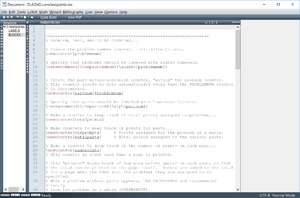
For example if you forget to close a curly brace which encloses, say, italics, LaTeX won't report this until something else occurs which can't happen until the curly brace is encountered (e.g.

Most error messages are self-explanatory, but be aware that the place where LaTeX spots and reports an error may be later in the file than the place where it actually occurred. If you find another error message not shown here, and it's not clear what you should do, ask for help. Only a few common error messages are given here: those most likely to be encountered by beginners. While it is certainly possible to set LaTeX's parameters so that the spacing is sufficiently sloppy that you will almost never get a warning about badly-fitting lines or pages, you will almost certainly just be delaying matters until you start to get complaints from your readers or publishers. Unlike other systems, which try to hide unevennesses in the text (usually unsuccessfully) by interfering with the letter spacing, LaTeX takes the view that the author or editor should be able to contribute. Warnings don't begin with an exclamation mark: they are just comments by LaTeX about things you might want to look into, such as overlong or underrun lines (often caused by unusual hyphenations, for example), pages running short or long, and other typographical niceties (most of which you can ignore until later). Some systems (Emacs is one example) run LaTeX with a "nonstop" switch turned on, so it will always process through to the end of the file, regardless of errors, or until a limit is reached. Plow through any errors, unless too many pile up and it fails (100 errors). You still have to make that correction in the editor). (followed by a correction) means input the correction in place of the error and carry on (This is only a temporary fix to get the file processed. Stop the program but re-position the text in my editor at the point where you found the error (This only works if you're using an editor which LaTeX can communicate with). You must type one of the following letters toĬarry on quietly as best you can and don't bother me with any more error messages. When LaTeX finds an error like this, it displays the error message and pauses. Here's an example, showing that the user mistyped the \tableofcontents Error messages begin with an exclamation mark at the start of the line, and give a description of the error, followed by another line starting with the number, which refers to the line-number in your document file which LaTeX was processing when the error was spotted. The format of an error message is always the same.

3.8 Package babel Warning: No hyphenation patterns were loaded for the language X.3.6.1 Easily spotting overfull hboxes in the document.Some of the most common errors are described in the next sections.

Errors are easily spotted and easily corrected in your editor, and you can then run LaTeX again to check you have fixed everything. It may also display warnings for less serious conditions.ĭon't panic if you see error messages: it is very common to mistype or misspell commands, forget curly braces, type a forward slash instead of a backslash, or use a special character by mistake. If it encounters something it doesn't understand or can't do, it will display a message saying what is wrong. LaTeX describes what it is typesetting while it does it. Collaborative Writing of LaTeX Documents.Scientific Reports (Bachelor Report, Master Thesis, Dissertation).


 0 kommentar(er)
0 kommentar(er)
